Do-it-yourself heating of a private house: how to provide
Arrange heating in a private house with their own hands - the task is not trivial, and feasible not for everyone. Yes, and with the financial side of the issue, too, everything is not easy: and heating devices, communications, and permits require very considerable funds.
And yet you can cope with this project, especially if you take it after the fundamental theoretical training.
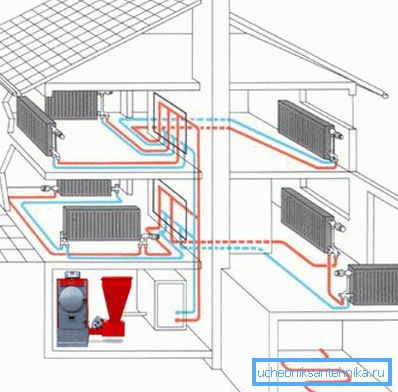
Calculate system parameters
Before building blueprints for heating a private house, we need to decide what the capacity of the system we are designing will be. We pledge more than necessary - expenses will increase, we will install less - in winter (and in some regions of the Russian Federation the temperature in winter may drop to -30 - 40 degrees, or even more) heating will simply not cope with the tasks.

To find the optimal power of the heating system, you need to perform some calculations:
- At the first stage, we determine the heat loss of the building. They depend on the area of the house, the material, the walls, the number of windows, the quality of the glazing, etc. Professional heat engineers take into account all these values in fairly complex formulas, but we can use such a program as a heating calculator for a private house.
- Having entered the initial data into the calculator, we should get a value in the range from 50 to 150 W / m2.
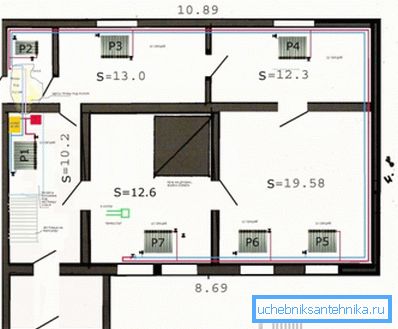
- The resulting figure is multiplied by the area of our house and add about 20% - so we find out the necessary power of the heating device (boiler or stove).
- Next, we determine how many radiators we will need for each room. The easiest way to do this is to calculate the specific heat transfer: it takes 41 watts of heat to burn 1 cubic meter of internal space, respectively, we just need to multiply the area of the room by its height and this coefficient.
Note! Central heating in a private house can use a variety of batteries that differ in heat transfer. That is why the number of radiator panels or sections (for prefabricated structures) must be determined on the basis of the thermal characteristics of a particular model.
In addition, we may need to calculate the volume of coolant (for the selection of the expansion tank of the appropriate capacity), as well as the hydraulic resistance of pipelines. All these calculations are also convenient to make with the help of calculators.
Water heating
Choosing a boiler
Heating and hot water of a private house can be implemented according to different schemes. The most commonly used is water heating, in which hot water or a special non-freezing fluid acts as a coolant.
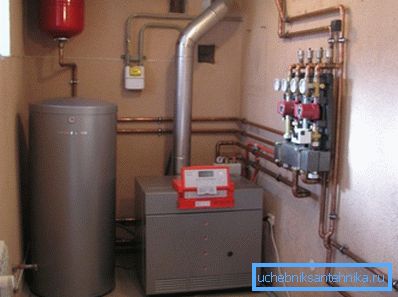
The basis of such a system is a boiler of appropriate capacity.
You need to choose it depending on which energy source is the most affordable and will ensure the most profitable spending of funds:
- For smaller houses, electric (TEN or electrode) boilers are suitable.. They are quite simple in installation and operation, provide effective management of heating parameters, are easily configured and combined with climate control systems. However, the level of energy consumption of such units is very high, so the cost of electric heating in a private house will be rather big.
- Gas heaters - the universal solution. Such boilers are reliable, productive and economical. So if you have access to the gas pipeline - do not be lazy to get permission to install gas heating.
Note! If gasification of your site is planned in the near future, it is possible to install a liquid-fuel heating boiler. Many models of such devices either allow combined heating (gas / fuel oil, gas / diesel), or can be converted into gas by replacing several nodes.
- The third type of boilers - solid fuel. They have less efficiency, but they ensure your complete autonomy. With such a device, you can be sure that the heat in the house will depend only on the supply of coal, wood or pellets in your barn.
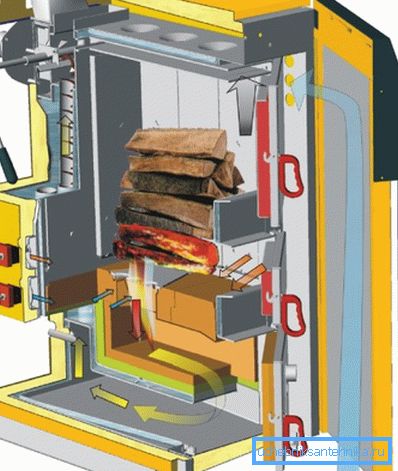
In addition to the boiler itself, additional equipment will be needed for the installation of the heating system: faucets for hot and cold water, taps (both conventional shut-off and thermostatic), expansion tanks, etc.
A circulating pump is also a useful part: having installed it in the system, we will increase the speed of the coolant inside the circuit, and the rooms will warm up more evenly.
Tip! If you use an electric heating boiler, then it is advisable to purchase at least a compact generator on diesel or gasoline. Otherwise, when you turn off the electricity, you can stay not only without light, but without heat.
We mount radiators
In order for the coolant from the boiler to provide a comfortable temperature in the rooms, we need to install radiators in them. And here it is desirable to abandon the traditional cast-iron products: yes, they are reliable and durable, but in terms of heat transfer they significantly lose to more modern varieties.

Instead of cast iron batteries, you can use:
- Steel - light, fairly cheap, but prone to corrosion.
- Aluminum - an excellent solution for a private house because of good heat transfer and relatively low hydraulic strength. In addition, aluminum in the presence of alkali begins to break down, so that water treatment should be given the closest attention.
- Bimetallic - they are distinguished by high efficiency, practically non-corrosive, they are not afraid of pressure drops in the system. If it were not for the high price - bimetallic radiators could be recommended as a universal option.
Tip! To effectively use a less hot heat carrier (and, consequently, save fuel for the boiler), it is worth adding two or three pieces to the number of sections determined by calculation. The cost of equipment will increase slightly, and these costs will pay off in the first year.

- The radiators are mounted on the walls of the rooms and under the window sills, while ensuring that there is a gap of 60-100 mm below for access of cold air, and a gap for the exit of hot air from above. If the window sill is located directly above the battery, then it is necessary to make special holes in it, otherwise the loss of heat transfer will reach 20-25%.
- To connect the radiators use pipes. Instead of obsolete steel varieties that rust and lose strength over time, you can use plastic equipment made of heat-resistant polypropylene or metal-plastic products. They are easily assembled with their own hands using special fittings, and their service life is 20 years or more.

Note! Heating of private houses using high-temperature (up to 130 0 С) steam makes greater demands on the strength of pipelines. So the plastic can not be used here: either steel or copper!
- Naturally, all elements of the system must be tightly connected. To detect leaks, the system is subjected to pressure testing, and if everything is in order, we carry out a trial start of the boiler.
At the same time, it is desirable that a specialized organization be involved in the commissioning work - this is how we will take off a significant share of the risks that arise.
Electric heating
Wiring requirements
When deciding how to heat a private house, many abandon traditional systems in favor of electrical heating. This scheme may be justified if there is a stable centralized power supply in your area, but even in this case there are a number of restrictions.
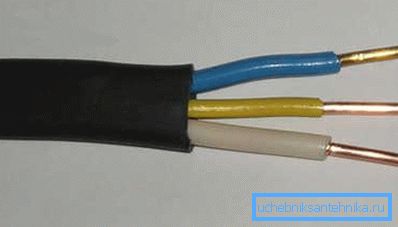
One should be aware that both infrared panels and electroconvectors consume a large amount of electricity. Standard wiring will not stand it for sure, therefore it will have to be re-laid.
The requirements for wires used to connect heaters are shown in the table below:
| Wire material | Wire section, mm2 | Maximum power, kW | Maximum current, And |
| Aluminum | 2 * 2.5 | 4.5 | 28 |
| 2 * 4.0 | 6.0 | 20 | |
| Copper | 2 * 1.0 | 3.5 | sixteen |
| 2 * 1.5 | 4.0 | nineteen | |
| 2 * 2.5 | 5.8 | 27 |
Note! Wiring for connection is laid in a hidden way. If the walls of the building are made of combustible material (wood, drywall), the use of metal covers or fire-resistant plastic is mandatory.
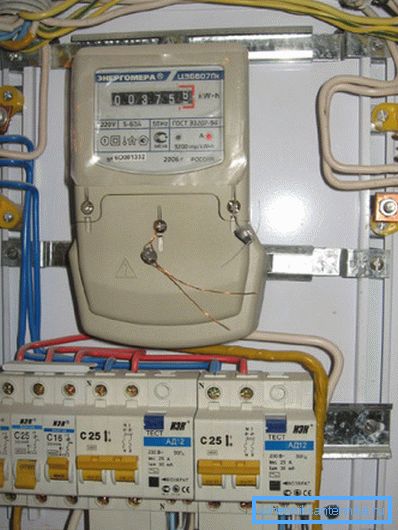
In addition, for each heating circuit with a capacity of 2 kW and more, it is desirable to install a separate protective shutdown device (RCD) on the panel. In this case, if the wiring fails under load, the system will be protected from short circuit.
Equipment installation
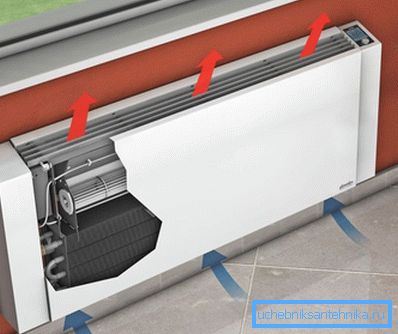
In order to organize efficient heating of a private house using electric heaters, it is important to choose the most productive, but economical radiators and converters:
- Oil radiator batteries are suitable as a temporary solution, as well as for additional heating. It is better to use them when the main circuit either does not cope or is simply missing.
- The most common option for arranging electrical heating will be the installation of convector systems. Convectors are installed either on the walls or in special niches in the floor. It is advisable to connect them to the hidden wiring to minimize the number of wires in the rooms.
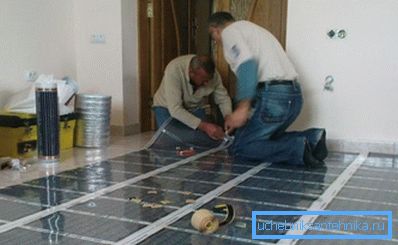
- Heated electric floor is another good solution. Automation of temperature control allows you to maintain a comfortable microclimate in the room, while energy resources are saved due to the most rational distribution of heat flows.
- Infrared heating of a private house is one of the most environmentally friendly. Although the infrared heaters themselves are quite expensive, they not only consume relatively little electricity, but do not burn precious oxygen.
As in the case of pipes, for the start-up and adjustment of the system, it is better to invite electricians with an appropriate level of tolerance. This is also important because of fire safety: you should not joke with wiring, especially under high voltage.
If you want to equip almost free heating, then consider options using solar or wind energy. Of course, the equipment for such heating will be expensive, but on average, these costs pay off over a period of three to five years, depending on the technology chosen.

Conclusion
It's over, it's impossible to tell all about heating in one article. However, the above advice on the selection of equipment and the rules of its installation will be very useful to anyone who plans to do an independent home improvement. Well, and more detailed information contains video on this page, and also other materials of this section.